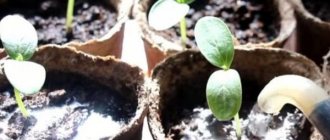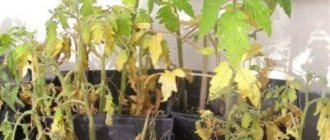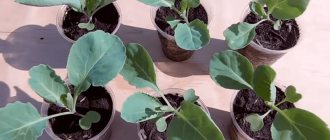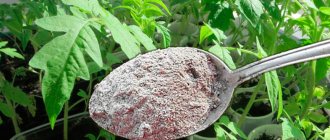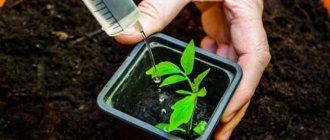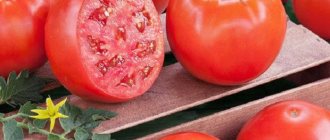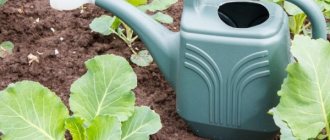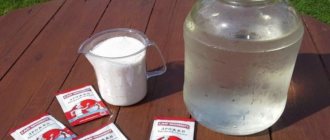Why do you need feeding?
Tomato seedlings need careful care, consisting of proper lighting, maintaining the required air temperature, timely watering and fertilizing.
Feeding tomato seedlings is indispensable if the seeds were sown in poor soil or grew for too long in one, cramped container and completely exhausted all useful substrate reserves.
For full growth and development of tomato seedlings, a complex of micro- and macroelements is required, including nitrogen, potassium and phosphorus.
With a lack of these nutrients, seedlings begin to lag in growth, weaken and become thin. Therefore, it is very important to promptly identify nutritional deficiencies and solve this problem with the help of fertilizers.
The main signs of a lack of useful elements:
- Nitrogen is necessary for rooting, active growth and rapid expansion of vegetative mass. With a nitrogen deficiency, the lower leaves of the seedlings become lighter in color, begin to curl, and the seedlings lag behind in growth and weaken.
- Phosphorus - this element ensures the full development and strengthening of the root system, and also increases resistance to diseases and pests. With its deficiency, the leaf plates begin to curl downwards, the growth of seedlings slows down, and the stem acquires a purple hue.
- Potassium - it is this element that is “responsible” for the immune system and fruiting of the crop. Potassium deficiency can be determined by a decrease in the size and darkening of the leaves, their curling, and the appearance of dark spots on the surface of the leaves.
- Calcium – accelerates the growth of the root system and promotes rapid rooting in a new place. If there is a lack of calcium, the growth of seedlings stops, light-colored spots appear on the leaves, and the edges of the leaf blades begin to die.
- Iron – ensures rapid development of tomato seedlings. Without this element, the sprouts begin to turn yellow in the direction from the stem to the leaves, and the veins turn white.
When applying fertilizers, you need to take into account that their excess is no less harmful to tomato seedlings than their deficiency.
If the foliage of seedlings becomes excessively bright, this indicates an excess of nitrogen; its yellowing and falling indicates an excessive concentration of phosphorus.
How to determine which substances are missing
To determine the need for fertilizing, you need to know about the signs of a lack of a certain element for tomatoes:
- The lower leaves of the seedlings began to turn yellow - there is little nitrogen in the soil.
- A lack of phosphorus results in the back of the leaf turning purple.
- The roots of the seedlings will be weak and underdeveloped due to the low potassium content. And the leaves of the grown seedlings will begin to wrinkle, curl and dry out.
- Pale leaves with noticeable green veins on seedlings that lack iron.
- Seedlings with thin, elongated stems are obtained when calcium levels in the soil decrease.
You should also not overfeed tomatoes with fertilizers. So, a lot of nitrogen will result in leaf curling . Everything needs balance. You need to think about this before you start fertilizing.
First feeding
The first feeding of tomato seedlings is carried out immediately after the appearance of the first 2-3 true leaves. For the first feeding, both industrial compounds and folk remedies are used:
- Agricola;
- Nitrophoska;
- Agromax;
- yeast;
- wood ash.
For this purpose, you can use Nitroamophoska, adding 1/3 teaspoon of the drug to a bucket of water. This remedy replenishes the lack of nitrogen, phosphorus and other useful micro- and macroelements.
What to feed after picking
Feeding of tomato seedlings is carried out 12-14 days after picking in separate containers.
Effective fertilizers:
- Urea – dissolve 10 grams of the product in 5 liters of warm water and use to spray seedlings.
- Ammonium nitrate - 5 grams per 10 liters of water are used to prepare the fertilizer.
- Boric acid - dissolve 1 gram of the drug in 1 liter of water and use for spraying.
Regular yeast will be a good fertilizer. Dissolve 50 grams in 5 liters of water and add 2-3 tablespoons of granulated sugar. Leave to infuse for 4 days and dilute with 5 liters of water. Use for watering seedlings.
Conditions for strong seedlings
Before you can get good plants, you need to first prepare the soil for this. The quality of plants is affected by:
- seed material. Seeds must have a normal shelf life, be treated and germinated. Hybrid tomato varieties do not need to be germinated;
- priming. The richer the soil composition, the faster the seedlings will appear. The soil must contain peat, humus, mineral fertilizers, ash, and river sand. The specified components are mixed with soil brought from a summer cottage, and then the soil is calcined in the oven for 1-2 hours for disinfection;
- sowing time and scheme. For the central zone of the country, seeds begin to be planted from the end of February and throughout March. To grow tomatoes in Siberia and the Urals, seeds are sown from the beginning of February. The planting scheme is suggested on the package with the seeds, but if there are no instructions, then the minimum distance between the grains should not be closer than 4-5 cm.
After planting, the plants need to create favorable conditions for growth. Place the box with the planted seeds in a well-lit place with a temperature of 25-28 degrees Celsius, and periodically moisten the soil.
Then, in the 2-3 phase, the leaves of the plant must be planted in different cups so that they do not interfere with each other’s formation. After a couple of weeks from the moment of picking, it is possible to apply fertilizing.
Attention! After picking, they try to keep the tomato bushes at a lower temperature of about 22-24 degrees Celsius so that they get used to normal conditions a little.
Industrial fertilizers
To feed tomato seedlings, you can use industrial fertilizers, available in a huge assortment in gardening stores.
Complex mineral fertilizers have a positive effect on seedlings - they compensate for the lack of all useful elements, strengthen the immune system, stimulate the growth and development of the root system and vegetative part.
Athlete
Athlete is one of the most popular and widespread means for strengthening and growing tomato seedlings. This drug prevents the overgrowth of seedlings, in particular its above-ground parts, strengthens the root system, promotes thickening of stems and an increase in the size of leaf blades.
Thanks to the inhibition of the growth of the above-ground part, stunted and weakened seedlings become shorter, but stronger and healthier. Athlete improves the absorption of nutrients by the plant, positively affecting its flowering and fruiting.
Sturdy
Krepysh is a popular organomineral fertilizer that ensures active growth and health of tomato seedlings. This universal product can be used to feed any vegetable crops - eggplant, cucumbers, bell peppers.
The composition of the drug Krepysh includes nitrogen, phosphorus, potassium, sulfur, boron, iron and other useful elements. They help strengthen and thicken the stems, accelerating the growth of thin shoots.
Emerald
Emerald is a fertilizer for express help for weakened, thin and yellowing seedlings suffering from a lack of nutrients. This product is specially developed by the manufacturer to restore normal nutrition and growth of tomato seedlings. Emerald can be used for root watering or spraying of young shoots.
The main active substance in the Izumrud fertilizer is nitrogen, supplemented with magnesium and other useful minerals. Before use, the concentrated fertilizer is diluted with water in the proportions specified in the manufacturer's instructions.
Hello
Zdraven belongs to complex mineral fertilizers, popular among summer residents and vegetable growers. This supplement contains an almost complete range of micro- and macroelements - nitrogen, potassium, phosphorus, boron, copper, selenium, iron.
The dosage of the drug when preparing the solution is indicated on the label. Most often, a universal fertilizer is used to feed tomato seedlings - 50 ml of Zdraven concentrate per 10 liters of water.
Zdraven promotes rapid growth and thickening of seedlings, faster development of the root system and above-ground parts.
Fertika Lux
Fertika Lux complex mineral fertilizer is well known to many summer residents and vegetable growers. It contains not only vital nitrogen, phosphorus and potassium, but also a wide range of other useful mineral elements.
The universal product Fertika Lux can be used to strengthen tomato seedlings, other vegetable crops, as well as ornamental garden and indoor plants. The fertilizer is concentrated, so before use it must be diluted with warm water.
Under no circumstances should you exceed the dosage specified in the instructions, otherwise you can burn the root system of tomato seedlings.
Folk remedies
Many summer residents and gardeners prefer to care for tomato seedlings using natural organic fertilizers. They are absolutely harmless to young seedlings, affordable and environmentally friendly.
Natural folk remedies are prepared on the basis of plant and natural ingredients that do not cause any harm to the seedlings and the future harvest.
Bird droppings
Chicken or pigeon droppings are a universal organic fertilizer useful for all types of vegetable crops. In order for the litter to bring maximum benefit to tomato seedlings, you need to take into account several basic rules for its use.
Basic rules for using bird droppings:
- the droppings are not used fresh - the concentrated product can burn the roots of the seedlings;
- Before use, the fertilizer is prepared - the droppings must be mixed with water and left to ferment for 2-5 days;
- To feed young seedlings, the prepared solution must be diluted with clean water in equal proportions.
This substance can be used in its natural form or you can buy granular litter, which is sold in gardening stores. This fertilizer is much easier to use than dry litter.
Onion peel
Many summer residents do not throw away onion peels, because they are an excellent natural remedy for feeding tomato seedlings. Effective decoctions and infusions are prepared from it, which nourish young sprouts, replenishing the lack of elements and stimulating the immune system.
To prepare the top dressing, pour 2 handfuls of onion peels into a 1 liter glass jar, fill to the brim with hot water and leave to steep for 24 hours. Use the prepared infusion to water tomato seedlings.
Read more in the article: “Feeding tomato seedlings with onion peels.”
Banana peel
Banana peel is a natural and effective fertilizer for tomato seedlings. It contains an increased concentration of potassium, as well as phosphorus, which ensures the full development of tomato seedlings.
Banana peels can be used in a variety of ways:
- The peel can be poured into a container or other container when picking grown seedlings.
- Banana peels can be dried, ground to a powder and used as a dry fertilizer or mixed with soil when planting seeds.
- Banana peels are used to prepare an infusion - pour the skins of 2 bananas into 2 liters of boiling water and leave to infuse for 3 days.
Before use, banana infusion must be diluted with clean water in equal proportions.
Wood ash
Wood ash remaining after burning wood is a real “record holder” for the content of phosphorus, potassium, calcium and magnesium. This is a universal and safe remedy that strengthens weakened and thin seedlings and makes them plump and healthy.
The method for preparing ash fertilizer is very simple - pour 100-150 grams of ash into 2 liters of hot water, cover with a lid and leave to infuse for 24 hours. This solution is used to water seedlings at the root.
Iodine
Iodine is a pharmaceutical drug that can be found in any home medicine cabinet. It can be used not only to treat wounds and abrasions, but also to feed tomato seedlings. This drug strengthens the immunity of seedlings and increases their resistance to diseases and bacteria.
To prepare iodine supplement, dissolve 3 drops of the drug in 3 liters of clean water.
This fertilizer is used only once throughout the entire period of growing tomato seedlings, preferably before planting the grown seedlings in the beds.
Coffee
Do not rush to throw away the spent coffee cake - it can become a good fertilizer for tomato seedlings. Coffee grounds not only contain a complex of micro- and macroelements, but also loosen the soil, improving its breathability.
To fertilize tomato seedlings, mix dried coffee grounds with soil and use for sowing tomato seeds or picking grown seedlings.
Common mistakes
- Fertilizers are applied at the wrong time. Each feeding has its time. For example, untimely watering with a nitrogen-containing preparation can cause tomatoes to begin to fatten or stretch.
- Violation of the maximum permissible concentration. This is a common mistake made by beginners. Having prepared the solution according to the instructions, they begin to doubt and add more active ingredient. This action leads to chemical burns.
- Excessive passion for “folk” recipes. Homemade fertilizers should play a supporting role. Constantly feeding tomatoes only organic matter is harmful.
- Adding solutions that have stood for several days. Only a small number of drugs retain their properties for a long period of time. Basically, fertilizing should be applied on the same day that it was diluted in water. In addition, some fertilizers begin to ferment, and their application has a negative effect on seedlings.
- Fertilizers are applied incorrectly. This is rarely mentioned, but root fertilizing needs to be done in moist soil. This way microelements are better absorbed by the plant.
- Incorrectly carried out procedure. Root feeding should be carried out in such a way that fertilizers do not get on the above-ground part of the tomatoes. Contact of young seedlings with chemicals leads to burns.
- Feeding with mullein and bird droppings. Organics should not be used when growing tomato seedlings at home. It is poorly processed and leads to fattening of seedlings.
- Feeding strong and healthy seedlings. If your tomatoes are developing and not getting sick, do not rush to feed them. Excess micronutrients will cause a lot of problems, including causing plant diseases.
What to feed when planting seedlings in open ground
When transplanting tomato seedlings to a permanent place, many gardeners and vegetable growers use growth stimulants, which promote the rooting of seedlings in the beds and activate their growth.
One of the most popular stimulants is Epin Extra. To prepare the fertilizer, dissolve 1 ml of the drug in 5 liters of water. Use for foliar treatment of tomato seedlings.
For root feeding, folk remedies are used - onion peels, banana peels or ammonia. To feed, dissolve 1 teaspoon of the drug in 10 liters of water. Water the sprouts at the root.
Feeding tomato seedlings is the key to their health and active growth. For fertilizing, you can use both industrial mineral compositions and folk remedies, which are easy and safe to use. When using fertilizers, you need to remember to be careful, as excess nutrients can cause serious harm to tomato seedlings.

